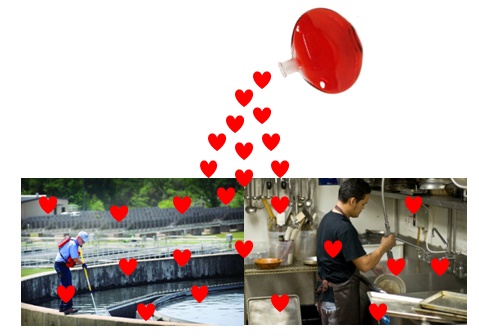.jpg)
Although sizing grease interceptors, whether gravity or hydromechanical, has always been based solely on flow rate, this strategy falls short in that it does not consider how much grease a specific food service facility could produce.
There are many times when volume or flow rate sizing would lead to the same size interceptor for a subway sandwich shop as for a Mexican grill, however it is well understood by inspectors that these two types of restaurants produce significantly different amounts of fats, oils and grease (FOG).
Schier recommends using a grease production calculation to determine how much grease a particular restaurant is likely to produce in order to ensure that the specified grease interceptor has sufficient grease storage capacity to allow for a realistic and affordable pump out frequency.

We developed the above categories for restaurants based on feedback from jurisdictions and pumper contractors around the country, combined with reports such as the
Brown Grease Study (Kennedy Jenks 2011) which gives detailed information about restaurant types and menu's as well as grease and solids production data.
The formula for calculating grease production requires three bits of information:
1. Grease production per meal - you simply have to decide by menu type which category (low, medium or high) that the restaurant falls under and then whether the restaurant uses flatware or disposable (plastic or paper) forks, knives, spoons, plates, cups, etc.
2. Meals or customers per day - if this is a franchise they typically have this information available. Independent start-ups may not know this information up front, in which case you may have to make an educated guess or phone a friend or consult a medium. Most of the time you can get close enough that the calculation makes sense. Just remember that its better to err on the high side.
3. Days per pump-out cycle - this is simply the maintenance cycle you plan to use for pumping out the interceptor. Most people will not maintain an interceptor that is sized to be cleaned out more often than once per month and most jurisdictions won't let an interceptor be maintained less often than once every 90 days. Somewhere in between is the sweet spot for your project.
The formula for calculating grease production is very straight forward. You simply take the amount of grease expected per meal (a,b,c,d,e, or f), times the number of meals expected per day, times the number of days between pump outs to arrive at the grease capacity required for the interceptor.
Lets take a couple of real-world examples:
Example 1
McDonalds (medium grease producer, no flatware - category "c")
400 meals per day X 0.025 lbs per meal = 10 lbs FOG per day, or 300 lbs every 30 days, or 600 lbs every 60 days, or 900 lbs every 90 days.
You can also take a grease interceptors' certified capacity and divide it by the amount of grease production per day, to determine the pump out frequency as follows:
10 lbs per day would require:
Schier GB-75, 75 gpm, 616 lbs = 61 days between pump-outs
Schier GB-250, 100 gpm, 1076 lbs = 108 days between pump-outs
Trapzilla TZ-400, 75 gpm, 400 lbs = 40 days between pump-outs
Trapzilla TZ-600, 75 gpm, 600 lbs = 60 days between pump-outs
Mifab BigMax 750, 75 gpm, 150 lbs* = 15 days between pump-outs
Mifab BigMax 1150, 100 gpm, 200 lbs* = 20 days between pump-outs
*based on grease interceptors' actual third party certification (not based on the manufacturer's claims of performance, which cannot be proven).
Example 2
Buffalo Wild Wings (high grease producer with flatware, category "f")
642 meals per day X 0.455 lbs per meal = 29.2 lbs per day, or 876 lbs every 30 days, or 1,752 lbs every 60 days, or 2,628 lbs every 90 days.
29.2 lbs per day would require:
Schier GB-75, 75 gpm, 616 lbs = 21 days between pump-outs
Schier GB-250, 100 gpm, 1076 lbs = 36 days between pump-outs
Trapzilla TZ-400, 75 gpm, 400 lbs = 14 days between pump-outs
Trapzilla TZ-600, 75 gpm, 600 lbs = 20 days between pump-outs
Mifab BigMax 750, 75 gpm, 150 lbs* = 5 days between pump-outs
Mifab BigMax 1150, 100 gpm, 200 lbs* = 7 days between pump-outs
Of course you can increase capacity by increasing the number of interceptors in order to lengthen the pump-out cycle, i.e:
Schier GB-250 (2), 100 gpm, 2152 lbs = 74 days between pump-outs
Using the grease production sizing method is not limited to any specific manufacturer, you can use it for any interceptor.

The only thing to watch out for is the funny-business some manufacturers' play in making unsubstantiated claims of capacity that they want to be used in determining a pump-out frequency.
Sorry Charlie, that's just not going to work.
When in doubt ask them for their certified test reports to see what their actual/real/genuine/true/factual capacity is, then base the pump-out cycle on that.
























.jpg)



